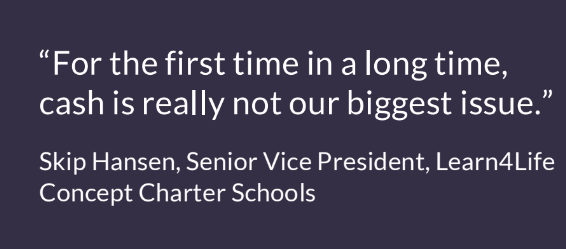Why are Receivable Sales Beneficial to Charter Schools?
Charter schools often have difficulty accessing capital from traditional sources for operations and growth. One method of financing widely used by many industries is receivable sales. This reliable and flexible transactional process, pioneered by Charter School Capital for charter schools, provides access to capital needed to support operations, facilities, programmatic expenses, or other obligations.
What is a receivable sales transaction?
In a receivable sales transaction, Charter School Capital purchases state aid payments due to the charter school from the state and, in exchange, provides funding to the school in advance of the state payment distribution date. The state payment remains with the state until the scheduled distribution date arrives. Charter School Capital assumes the timing risk if the state delays the distribution of the payments due to the school. There are no additional costs to the charter school in the event the state delays payments.
How are the amounts available to the charter school calculated?
Amounts available for a charter school to sell to Charter School Capital are typically established by attendance-based entitlements or eligible grants owed to the charter school. Selling attendance-based entitlements and grants gives the charter school community access to much-needed capital when they need it, so schools are able to focus on educating students.
How does the receivable sales program work?
Charter School Capital and the charter school enter into a receivables purchase agreement and execute a bill of sale. Executing these agreements transfers ownership of the state payment to Charter School Capital and the school receives the agreed-upon funding. When the state distributes the payment to Charter School Capital, the funds are then distributed as outlined in the bill of sale.
What are the costs associated with the sale of receivables?
There are only two costs involved in our sale of receivables, the program fee and the discount.
- The program fee is a fixed fee for the transaction.
- The discount is the cost of selling a receivable and is determined by market-related factors including but not limited to the type of receivable being sold, the time the receivable is outstanding, and the credit-risk profile of the school. The discount is determined at the time of sale and does not change after the sale has occurred
Why choose receivable sales as a financing option?
- Selling attendance-based and other receivables helps accelerate a charter school’s ability to grow.
- Our qualification process is simple and more than 95 percent of schools that apply qualify.
- Schools have the ability to adjust funding levels to align with cash flow needs for existing operations or growth
- The sale of receivables is a reliable and flexible option for raising much-needed capital for charter schools.
If you’d like a printable PDF version of this information, download it here.
 Charter School Capital is committed to the success of charter schools and has solely focused on funding charter schools since the company’s inception in 2007. Our depth of experience working with charter school leaders and our knowledge of how to address charter school financial and operational needs have allowed us to provide over $1.6 billion in support of 600 charter schools that educate 800,000 students across the country. For more information on how receivable sales will benefit your charter school, contact us!
Charter School Capital is committed to the success of charter schools and has solely focused on funding charter schools since the company’s inception in 2007. Our depth of experience working with charter school leaders and our knowledge of how to address charter school financial and operational needs have allowed us to provide over $1.6 billion in support of 600 charter schools that educate 800,000 students across the country. For more information on how receivable sales will benefit your charter school, contact us!

